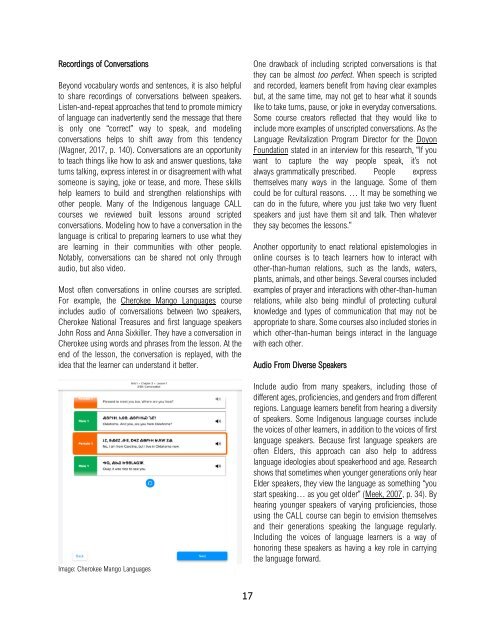Learning in Relation: A Guide to Creating Online Indigenous Language Courses that Center Indigenous Ways of Knowing and Being
by Kari A. B. Chew, Ph.D. (Editor & Author), Melvin Calls Him Jr. (Author), Jackie Dormer (Author), and Courtney Tennell (Author) The purpose of this guide is to share knowledge with Indigenous Nations and organizations, technology developers, and scholars who are working to center and respect Indigenous ways of knowing and being in online Indigenous language revitalization spaces, including Indigenous language courses. Citation Chew, K. A. B. (Ed.). (2022). Learning in relation: A guide to creating online Indigenous language courses that center Indigenous ways of knowing and being. http://hdl.handle.net/1828/14403
by Kari A. B. Chew, Ph.D. (Editor & Author), Melvin Calls Him Jr. (Author), Jackie Dormer (Author), and Courtney Tennell (Author)
The purpose of this guide is to share knowledge with Indigenous Nations and organizations, technology developers, and scholars who are working to center and respect Indigenous ways of knowing and being in online Indigenous language revitalization spaces, including Indigenous language courses.
Citation
Chew, K. A. B. (Ed.). (2022). Learning in relation: A guide to creating online Indigenous language courses that center Indigenous ways of knowing and being. http://hdl.handle.net/1828/14403
Create successful ePaper yourself
Turn your PDF publications into a flip-book with our unique Google optimized e-Paper software.
Record<strong>in</strong>gs <strong>of</strong> Conversations<br />
Beyond vocabulary words <strong>and</strong> sentences, it is also helpful<br />
<strong>to</strong> share record<strong>in</strong>gs <strong>of</strong> conversations between speakers.<br />
Listen-<strong>and</strong>-repeat approaches <strong>that</strong> tend <strong>to</strong> promote mimicry<br />
<strong>of</strong> language can <strong>in</strong>advertently send the message <strong>that</strong> there<br />
is only one “correct” way <strong>to</strong> speak, <strong>and</strong> model<strong>in</strong>g<br />
conversations helps <strong>to</strong> shift away from this tendency<br />
(Wagner, 2017, p. 140). Conversations are an opportunity<br />
<strong>to</strong> teach th<strong>in</strong>gs like how <strong>to</strong> ask <strong>and</strong> answer questions, take<br />
turns talk<strong>in</strong>g, express <strong>in</strong>terest <strong>in</strong> or disagreement with what<br />
someone is say<strong>in</strong>g, joke or tease, <strong>and</strong> more. These skills<br />
help learners <strong>to</strong> build <strong>and</strong> strengthen relationships with<br />
other people. Many <strong>of</strong> the <strong>Indigenous</strong> language CALL<br />
courses we reviewed built lessons around scripted<br />
conversations. Model<strong>in</strong>g how <strong>to</strong> have a conversation <strong>in</strong> the<br />
language is critical <strong>to</strong> prepar<strong>in</strong>g learners <strong>to</strong> use what they<br />
are learn<strong>in</strong>g <strong>in</strong> their communities with other people.<br />
Notably, conversations can be shared not only through<br />
audio, but also video.<br />
Most <strong>of</strong>ten conversations <strong>in</strong> onl<strong>in</strong>e courses are scripted.<br />
For example, the Cherokee Mango <strong>Language</strong>s course<br />
<strong>in</strong>cludes audio <strong>of</strong> conversations between two speakers,<br />
Cherokee National Treasures <strong>and</strong> first language speakers<br />
John Ross <strong>and</strong> Anna Sixkiller. They have a conversation <strong>in</strong><br />
Cherokee us<strong>in</strong>g words <strong>and</strong> phrases from the lesson. At the<br />
end <strong>of</strong> the lesson, the conversation is replayed, with the<br />
idea <strong>that</strong> the learner can underst<strong>and</strong> it better.<br />
Image: Cherokee Mango <strong>Language</strong>s<br />
One drawback <strong>of</strong> <strong>in</strong>clud<strong>in</strong>g scripted conversations is <strong>that</strong><br />
they can be almost <strong>to</strong>o perfect. When speech is scripted<br />
<strong>and</strong> recorded, learners benefit from hav<strong>in</strong>g clear examples<br />
but, at the same time, may not get <strong>to</strong> hear what it sounds<br />
like <strong>to</strong> take turns, pause, or joke <strong>in</strong> everyday conversations.<br />
Some course crea<strong>to</strong>rs reflected <strong>that</strong> they would like <strong>to</strong><br />
<strong>in</strong>clude more examples <strong>of</strong> unscripted conversations. As the<br />
<strong>Language</strong> Revitalization Program Direc<strong>to</strong>r for the Doyon<br />
Foundation stated <strong>in</strong> an <strong>in</strong>terview for this research, “If you<br />
want <strong>to</strong> capture the way people speak, it’s not<br />
always grammatically prescribed. People express<br />
themselves many ways <strong>in</strong> the language. Some <strong>of</strong> them<br />
could be for cultural reasons. … It may be someth<strong>in</strong>g we<br />
can do <strong>in</strong> the future, where you just take two very fluent<br />
speakers <strong>and</strong> just have them sit <strong>and</strong> talk. Then whatever<br />
they say becomes the lessons.”<br />
Another opportunity <strong>to</strong> enact relational epistemologies <strong>in</strong><br />
onl<strong>in</strong>e courses is <strong>to</strong> teach learners how <strong>to</strong> <strong>in</strong>teract with<br />
other-than-human relations, such as the l<strong>and</strong>s, waters,<br />
plants, animals, <strong>and</strong> other be<strong>in</strong>gs. Several courses <strong>in</strong>cluded<br />
examples <strong>of</strong> prayer <strong>and</strong> <strong>in</strong>teractions with other-than-human<br />
relations, while also be<strong>in</strong>g m<strong>in</strong>dful <strong>of</strong> protect<strong>in</strong>g cultural<br />
knowledge <strong>and</strong> types <strong>of</strong> communication <strong>that</strong> may not be<br />
appropriate <strong>to</strong> share. Some courses also <strong>in</strong>cluded s<strong>to</strong>ries <strong>in</strong><br />
which other-than-human be<strong>in</strong>gs <strong>in</strong>teract <strong>in</strong> the language<br />
with each other.<br />
Audio From Diverse Speakers<br />
Include audio from many speakers, <strong>in</strong>clud<strong>in</strong>g those <strong>of</strong><br />
different ages, pr<strong>of</strong>iciencies, <strong>and</strong> genders <strong>and</strong> from different<br />
regions. <strong>Language</strong> learners benefit from hear<strong>in</strong>g a diversity<br />
<strong>of</strong> speakers. Some <strong>Indigenous</strong> language courses <strong>in</strong>clude<br />
the voices <strong>of</strong> other learners, <strong>in</strong> addition <strong>to</strong> the voices <strong>of</strong> first<br />
language speakers. Because first language speakers are<br />
<strong>of</strong>ten Elders, this approach can also help <strong>to</strong> address<br />
language ideologies about speakerhood <strong>and</strong> age. Research<br />
shows <strong>that</strong> sometimes when younger generations only hear<br />
Elder speakers, they view the language as someth<strong>in</strong>g “you<br />
start speak<strong>in</strong>g… as you get older” (Meek, 2007, p. 34). By<br />
hear<strong>in</strong>g younger speakers <strong>of</strong> vary<strong>in</strong>g pr<strong>of</strong>iciencies, those<br />
us<strong>in</strong>g the CALL course can beg<strong>in</strong> <strong>to</strong> envision themselves<br />
<strong>and</strong> their generations speak<strong>in</strong>g the language regularly.<br />
Includ<strong>in</strong>g the voices <strong>of</strong> language learners is a way <strong>of</strong><br />
honor<strong>in</strong>g these speakers as hav<strong>in</strong>g a key role <strong>in</strong> carry<strong>in</strong>g<br />
the language forward.<br />
17




